Safely Working on Green Roofs
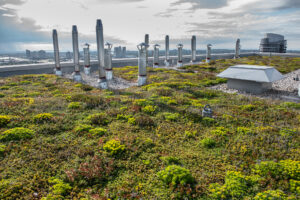
Photo: NLSM/Greg Van Riel
Fall accidents, injuries, and deaths happen in the workplace, every year. According to Occupational Healthy and Safety (OHS) Canada, more than 40,000 workers get hurt each year because of falls. These accidents are a result of poor safety practices, failure to set up proper protective equipment and lack of training.
Building owners are required to provide contractors with a workplace free from recognized hazards. Green roof workers often need to get close to the edge of the roof during installation and maintenance. Protecting installers and maintenance crews on a green roof is not optional. It is a necessity and required by law. The Canadian Centre for Occupational Health and Safety (CCOHS) provides a list of legislation from across Canada that requires very specific fall protection measures in addition to personal protective equipment (PPE). Let’s read how to keep everyone safe on a green roof.
Fall Prevention and Safe Access is Key
If possible, a walkout is ideal for roofs that require regular access. Otherwise, safe access points are very important as are footpaths and walkways for maintenance crews.
Rooftops higher than 2.4 m (8 ft) must have fall prevention or fall arrest systems to ensure rooftop safety for all. A parapet height of 1070 mm (42”) or higher acts as a guard and can avoid fall protection requirements altogether.
Good Design – Getting it Right From the Start
While the employer and workers are required to take the necessary steps to reduce risk, fall prevention starts with the designer. Safe design of a structure is critical to reduce or eliminate fall hazards during the construction phase, and for the routine maintenance that follows. Maintenance requirements for green roofs should be planned for at the design stage, and provision needs to be made for safety systems so that work can be carried out safely.
Basic Types of Fall Protection
1) Lifeline and anchors
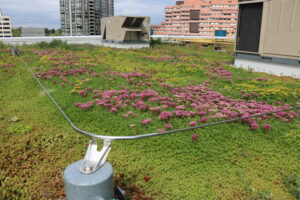
Travel restraint lifeline on the Yonge Sheppard Centre green roof, Toronto, Canada.
Engineered lifelines and anchor points are the most popular travel restraint and fall arrest systems. They are permanently attached to the roof’s structure through various securement options depending on the construction type. These systems keep people safe from the unprotected edge by physically connecting a worker’s PPE to the anchor point. Workers are required to be trained and certified in Working at Heights and Fall Protection.

Fall-arrest anchors on 4 The Kingsway. Photo NLSM/Greg Van Riel
These systems work well during the construction phase and on ongoing maintenance visits.
Lifeline and anchor systems are available as fixed (attached) and ballasted (free standing). Ballasted is ideal in retrofit green roofs or when fixed roof anchors are not feasible. For information on ballasted anchors, contact NLSM.
2) Guardrails

Guardrails on Sherway Gardens’s green roof, Toronto. Photo NLSM/Greg Van Riel
Permanent guardrails are an excellent method of fall prevention where anchors and lifelines are not practical. They put a barrier between people on the roof and the unprotected edge thus removing the need for tying-off. They are an excellent choice for amenity-space-green-roofs to give people the freedom to move about. They also offer safety to maintenance workers. There are two types of permanent guardrails; freestanding and attached.
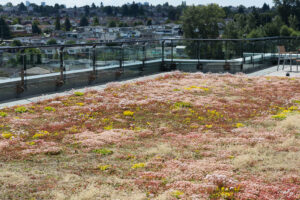
Permanent, attached, guardrails on the Broadway Tech Centre, Vancouver. Photo NLSM/Terry Guscott
Sherway Gardens green roof (above left) is an example of permanent free-standing safety guardrails.
Broadway Tech Centre (right) is an example of a permanent, attached, guardrail.
3) Warning line system
When the two above (lifeline, anchors and guardrails) are not feasible, a bumpline – a minimum of 2 m (6ft) from the unprotected edge of a roof – can be set up as a temporary warning line. This creates an enclosed control zone in which green roof work can be performed without the need to be tied-off. However, to construct the bumpline, workers must be tied-off. Therefore, at the very minimum one anchor must be provided, even in this situation. Bump lines can be left set up for the season, however they would need to be replaced every year due to UV degradation. Some owners may find this option unsightly.
4) Safe Access
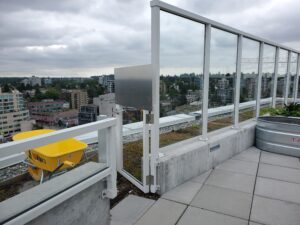
The green roof on Vancouver Masonic Temple is accessible to maintenance workers via this locked gate. Workers can then tie-off to the anchors safely.
While great strides have been made in rooftop safety over the years, green roof maintenance crews still face unseemly and challenging situations accessing rooftops. Workers have seen it all. In some cases they need to be mindful not to damage or soil private spaces as there is no access other than to walk through. In some cases, they must climb through windows, climb over glass railings (see picture on right) or clamber up from ladders that end prematurely. Sometimes workers have to carry heavy materials up several flights of stairs. Designers and specifiers can avoid the above with safe access through public elements, hallways, mechanical rooms, etc.
Elevator access to the roof level or as close as possible is ideal. This helps with safety and transportation of material during construction and maintenance to and from rooftops.
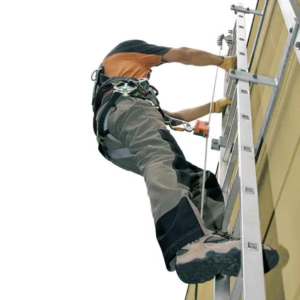
Fall-restriction ladder safety system by MSDirect.com
Vertical wall-mounted ladders, outside or inside, are also a popular mode of access for many green roofs. Fixed ladders should be long enough for workers to reach a grab bar or guardrail to ensure safely stepping onto the roof. Currently in Canada, ladders of a certain height need to have a protective cage. Roof hatches and cages need to accommodate workers’ various body sizes plus their backpacks which hold their tools and materials. Backpacks are necessary to ensure workers maintain a safe 3-point contact with the ladder at all times. Hatches should be installed safely away from the roof edge. Locking mechanisms should line up with the ladder to avoid a worker having to disengage one or both hands to unlock the latch.
For the safest use of a vertical ladder, designers should include a vertical lifeline system which greatly reduces the free-fall distance as the worker is connected by their PPE. This system works well during the construction phase and for ongoing maintenance visits.

NLSM’s team at Working at Heights Training. From left Sasha Aguilera, Sawsan Hlal, James Weldon and Alex Mozhzhukhina.
Worker Training: Keep Everyone Safe & Smiling
In addition to a safe, well-designed rooftop, regardless of the province in which they operate, employers must assess their roof safety plan and provide workers with Working at Heights / Fall Protection training. Employees must also take the necessary steps to reduce risk and be accountable for their own safety.
Canadian Centre for Occupational Health and Safety recommends working at heights safety training for employers, managers, and supervisors, including those who manage contractors. Working at heights certification is a mandatory requirement in many jurisdictions.
All the systems above and PPE equipment should be approved by the Canadian Standards Association (CSA).

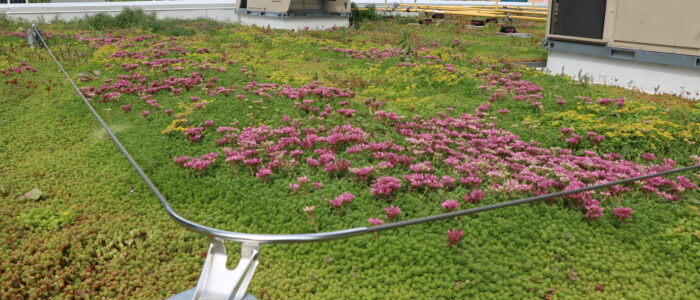
 Supplier of more than 2.5 M SQFT of Green Roofs
Supplier of more than 2.5 M SQFT of Green Roofs 
Comments are closed.